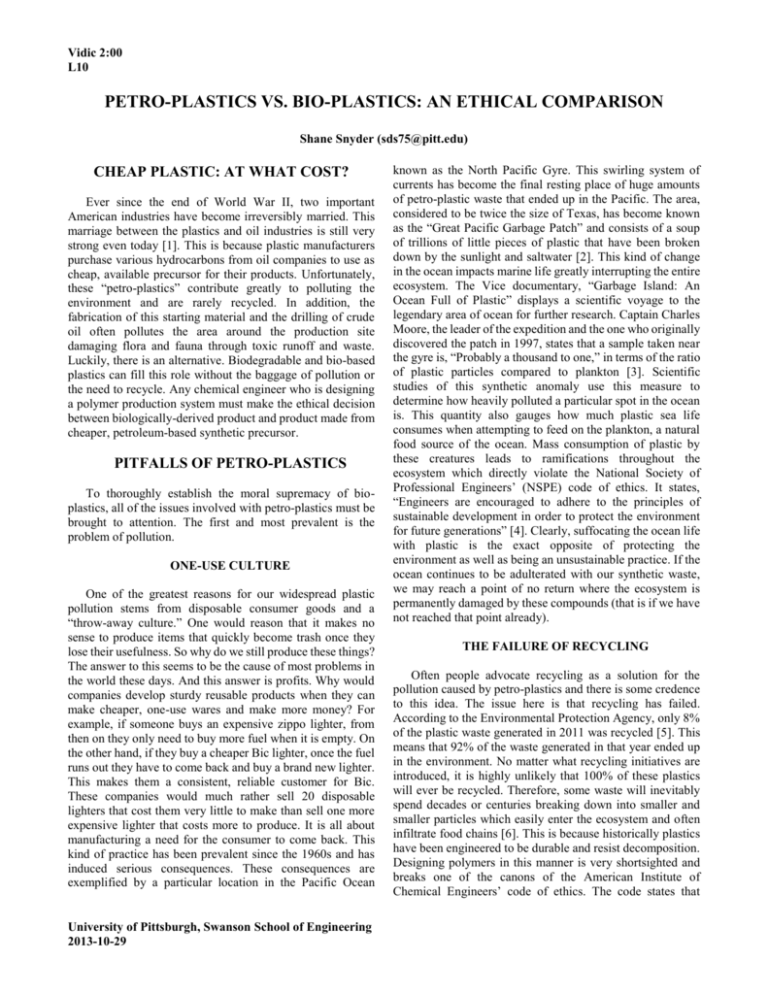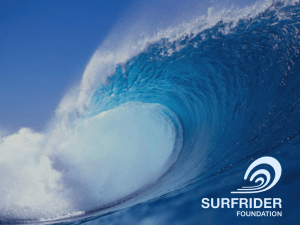Ethical Dilemma Between Petro-Based and Bio
advertisement

Vidic 2:00 L10 PETRO-PLASTICS VS. BIO-PLASTICS: AN ETHICAL COMPARISON Shane Snyder (sds75@pitt.edu) CHEAP PLASTIC: AT WHAT COST? Ever since the end of World War II, two important American industries have become irreversibly married. This marriage between the plastics and oil industries is still very strong even today [1]. This is because plastic manufacturers purchase various hydrocarbons from oil companies to use as cheap, available precursor for their products. Unfortunately, these “petro-plastics” contribute greatly to polluting the environment and are rarely recycled. In addition, the fabrication of this starting material and the drilling of crude oil often pollutes the area around the production site damaging flora and fauna through toxic runoff and waste. Luckily, there is an alternative. Biodegradable and bio-based plastics can fill this role without the baggage of pollution or the need to recycle. Any chemical engineer who is designing a polymer production system must make the ethical decision between biologically-derived product and product made from cheaper, petroleum-based synthetic precursor. PITFALLS OF PETRO-PLASTICS To thoroughly establish the moral supremacy of bioplastics, all of the issues involved with petro-plastics must be brought to attention. The first and most prevalent is the problem of pollution. ONE-USE CULTURE One of the greatest reasons for our widespread plastic pollution stems from disposable consumer goods and a “throw-away culture.” One would reason that it makes no sense to produce items that quickly become trash once they lose their usefulness. So why do we still produce these things? The answer to this seems to be the cause of most problems in the world these days. And this answer is profits. Why would companies develop sturdy reusable products when they can make cheaper, one-use wares and make more money? For example, if someone buys an expensive zippo lighter, from then on they only need to buy more fuel when it is empty. On the other hand, if they buy a cheaper Bic lighter, once the fuel runs out they have to come back and buy a brand new lighter. This makes them a consistent, reliable customer for Bic. These companies would much rather sell 20 disposable lighters that cost them very little to make than sell one more expensive lighter that costs more to produce. It is all about manufacturing a need for the consumer to come back. This kind of practice has been prevalent since the 1960s and has induced serious consequences. These consequences are exemplified by a particular location in the Pacific Ocean University of Pittsburgh, Swanson School of Engineering 2013-10-29 known as the North Pacific Gyre. This swirling system of currents has become the final resting place of huge amounts of petro-plastic waste that ended up in the Pacific. The area, considered to be twice the size of Texas, has become known as the “Great Pacific Garbage Patch” and consists of a soup of trillions of little pieces of plastic that have been broken down by the sunlight and saltwater [2]. This kind of change in the ocean impacts marine life greatly interrupting the entire ecosystem. The Vice documentary, “Garbage Island: An Ocean Full of Plastic” displays a scientific voyage to the legendary area of ocean for further research. Captain Charles Moore, the leader of the expedition and the one who originally discovered the patch in 1997, states that a sample taken near the gyre is, “Probably a thousand to one,” in terms of the ratio of plastic particles compared to plankton [3]. Scientific studies of this synthetic anomaly use this measure to determine how heavily polluted a particular spot in the ocean is. This quantity also gauges how much plastic sea life consumes when attempting to feed on the plankton, a natural food source of the ocean. Mass consumption of plastic by these creatures leads to ramifications throughout the ecosystem which directly violate the National Society of Professional Engineers’ (NSPE) code of ethics. It states, “Engineers are encouraged to adhere to the principles of sustainable development in order to protect the environment for future generations” [4]. Clearly, suffocating the ocean life with plastic is the exact opposite of protecting the environment as well as being an unsustainable practice. If the ocean continues to be adulterated with our synthetic waste, we may reach a point of no return where the ecosystem is permanently damaged by these compounds (that is if we have not reached that point already). THE FAILURE OF RECYCLING Often people advocate recycling as a solution for the pollution caused by petro-plastics and there is some credence to this idea. The issue here is that recycling has failed. According to the Environmental Protection Agency, only 8% of the plastic waste generated in 2011 was recycled [5]. This means that 92% of the waste generated in that year ended up in the environment. No matter what recycling initiatives are introduced, it is highly unlikely that 100% of these plastics will ever be recycled. Therefore, some waste will inevitably spend decades or centuries breaking down into smaller and smaller particles which easily enter the ecosystem and often infiltrate food chains [6]. This is because historically plastics have been engineered to be durable and resist decomposition. Designing polymers in this manner is very shortsighted and breaks one of the canons of the American Institute of Chemical Engineers’ code of ethics. The code states that Shane Snyder members shall, “Hold paramount the safety, health, and welfare of the public and protect the environment in performance of their professional duties” [7]. Clearly, the usefulness of these plastics and the profits to be had by their sale are being held above the welfare of the public and the environment. This “mess” of high molecular weight compounds are often toxic to wildlife including animals that many people eat. Of course they are also toxic to us. materials back to the ecosystem in a carbon-neutral process. In this way, PHAs and other bio-based polymers are inherently biodegradable. They represent a more long term and sustainable strategy to plastic production than petroleumbased precursor. Therefore it is also more ethical. A research paper written by Edmond Byrne, a professor in the Department of Processing and Chemical Engineering at University College Cork in Cork, Ireland, asserts, “There are two ways to kill any living thing. One is to do something that causes acute harm; the other is to remove or destroy the supporting environment and allow the living thing to perish. Similarly, engineers can destroy or alter environments that support the global ecosystem and in such manner kill future humans on a global scale. Clearly, the moral responsibilities of engineers must include commitments for providing a high quality and sustainable environment for future generations” [9]. What Byrne is saying is that sustainable design ensures the safety of future generations of humans. Looking at the issue of sustainability in this way coincides with the ethical theory of utilitarianism. According to an article written by Masaru Yonehara, an academic at Shizuoka University in Japan, utilitarianism describes a moral action as one that “Brings about the greatest balance of happiness over unhappiness for everyone affected by the action; otherwise, it is wrong” [10]. Byrne’s assessment of ensuring the safety of future humans by sustainable engineering aligns with the idea of finding a pragmatic balance where future suffering is minimized. TOXIC TO US Many synthetic polymer additives and plasticizers can “leach” out of the molecular structure that holds individual plastic monomers; escaping into the environment as well as consumer products enclosed in polymer containers. These additives are often drawn out of the polymer complex by lipids, as many are highly fat-soluble. Phthalates and many other polymer building blocks have been shown to be “endocrine disruptors.” Some of these monomers end up in our bodies and can interfere with natural processes by blocking hormone receptors. One such case is bisphenol-A, a monomer of polycarbonate, which has been used in water bottles and other household items. BPA is mentioned in Susan Freinkel’s book, Plastic: A Toxic Love Story. She writes, “Scientists have known since the 1930s that bisphenol-A acts as a weak estrogen [in the body]” [6]. The molecule bonds to receptor sites and can block stronger natural estrogen molecules, interfering with normal bodily activity. Many other common monomers such as PVC (polyvinyl chloride) are carcinogenic. Any engineer who, with knowledge of these health hazards, still chooses to produce these dangerous petroplastics is indisputably acting in an unethical manner. Both the NSPE and AIChE codes of ethics have a clause stating verbatim that their engineers must, “Hold paramount the safety, health, and welfare of the public” [4&7]. When engineers fail to live up to the expectations of their code in this way, the public’s safety, health, and welfare are not being properly protected. ROLE OF HUMANITY IN NATURE The ethical theory of utilitarianism is, of course, not the only way to frame the ethical dilemma of choosing between petro-based and bio-based plastics. The dilemma itself can also be framed differently as one of unsustainable practice versus sustainable practice. One author, Christian Becker, likes to outline the issue in terms of a different ethical theory: that of virtue ethics. This philosophy abides by the notion that suffering is caused by human imperfection and therefore the best way to minimize suffering is through human excellence. Excellence is to be achieved by embodying certain character virtues. The book Virtue Ethics by Nafsika Athanassoulis claims Aristotle’s (one of the originators of this theory) definition of virtue as, “…moral goodness, moral excellence” [11]. What is meant by moral excellence is a balance in certain character traits. For example, being cowardly is considered immoral, but exhibiting the trait of complete recklessness is just as problematic. Being courageous is the logical middle to the two extremes and would be considered superior to both. In the case of plastics and sustainability, Becker discusses “environmental virtues.” He states that attentiveness to nature is one these virtues and leads to a respect towards nature [12]. Needless to say, respecting nature includes not polluting it with millions of tons of synthetic petro-plastics and this is where bio-plastics come in. When these plastics biodegrade they return carbon back into the environment in a similar way BIO-PLASTICS: A SUITABLE ALTERNATIVE In recent years developments have been made in the production of plastic by biological means. Some materials have been developed and tested for their unique quality of being able to be hydrolyzed by certain bacteria through the use of a class of enzymes known as esterases. These enzymes help facilitate a reaction which breaks the ester linkages between individual molecular units. A couple examples of these materials are polylactic acid and multiple different polyhydroxyalkanoates (PHAs) [8]. The latter are actually produced by bacteria as a way to store energy (similar to animals storing energy as fat). As these materials are originally produced by bacteria, they can subsequently be eaten and broken down by bacteria returning the starting 2 Shane Snyder to the natural carbon cycle. In addition, they do not support oil extraction companies in their production. Petro-plastics on the other hand provide profits to oil companies which pollute themselves on top of the carbon dioxide (a greenhouse gas) that is generated when their hydrocarbon products are burned. REFERENCES [1] A. Tullo. (September 9, 2013). “Plastic Planet.” Chemical & Engineering News. (Online article). http://cen.acs.org/articles/91/i36/Plastic-Planet.html [2] L. Blomberg. (2011). “The Great Pacific Garbage Patch.” E- The Environmental Magazine. (Magazine article). Vol.22, Issue 3, pp. 8 [3] Moore, Charles. (September 6, 2012). “Garbage Island: An Ocean Full of Plastic.” Vice. (Online Documentary). http://www.vice.com/toxic/toxic-garbage-island-1-of-3 [4] (July 2007). “Code of Ethics for Engineers.” National Society of Professional Engineers. (Online document). http://www.nspe.org/resources/pdfs/Ethics/CodeofEthics/Co de-2007-July.pdf [5] (2013). “Plastics.” Environmental Protection Agency. (Website). http://www.epa.gov/osw/conserve/materials/plastics.htm [6] S. Freinkel. (2011). “Plastic: A Toxic Love Story.” New York, NY: Houghton Mifflin Harcourt. (Print book). pp. 81139 [7] “Code of Ethics.” American Institute of Chemical Engineers. (Online document). http://www.aiche.org/about/code-ethics [8] A. Tullo. (March 19, 2012). “Old Plastics, Fresh Dirt.” Chemical & Engineering News. (Online Article). [9] E. Byrne. (2012). “Teaching Engineering Ethics with Sustainability as Context.” International Journal of Sustainability in Higher Education. (Online research paper). Vol.13, Issue 3, pp.232 – 248 [10] M. Yonehara. (March 2012). “Utilitarianism and Rawls.” Bulletin of the Faculty of Education, Shizuoka University. Social and natural sciences and liberal arts series. (Online Journal Article). Vol.62, pp. 51-58 [11] N. Athanassoulis. (2013). “Virtue Ethics.” New York, NY: Bloomsbury Academic. (eBook). pp.61-66 [12] C. Becker. (2012). “Sustainability Ethics and Sustainability Research.” New York, NY: Springer. (eBook). pp.67-82 [13] (October 28, 2013). “Energy & Oil Prices.” Bloomberg. (Website). http://www.bloomberg.com/energy/ TAKING THE MORAL HIGH GROUND In order to ethically evaluate this choice between using petroleum formulations or biologically derived compounds for plastics, all of the pros and cons for each must be laid out and measured. It makes sense to first mention petro-plastics one and only advantage. This is, of course, in the area of cost. Despite the common complaints about gas prices, petroleum is still very inexpensive. Crude oil only costs about $100 per barrel [13]. For a barrel full of useful organic molecules, this is extremely cheap. This means that the chemical derivatives that are sold to plastic manufactures are also relatively cheap. Although, this will likely change in the future as oil becomes more scarce and hence more pricey. Next comes the issue of pollution. Petro-plastics are very stable, long-lasting compounds. This becomes problematic when they are discarded. Nature cannot recycle them in a reasonable timeframe leading to massive pollution demonstrated by the Great Pacific Garbage Patch as well as the plastic debris visible on any beach. Bio-plastics, on the other hand, biodegrade when discarded returning their nutrients back to the ecosystem in a natural way. Another point of comparison between the two approaches exists in the way they relate to the oil industry and sustainability in the bigger picture. By providing profits to oil companies, petro-plastics support the infrastructure of the oil industry as a whole; itself being unsustainable. The future of the industry relies on the idea that there is unlimited oil to be extracted from the world which is simply false. Fossil fuels take millions of years to materialize; a rate which will never be matched by the rate we currently extricate them. The industry is practically the definition of unsustainable. Bio-plastics do not rely on this ticking time bomb of uncertainty and do not support it financially. Lastly, the matter of human health must be brought up. Petro-plastics contain dangerous additives and plasticizers (plus the monomers of the polymer themselves) that often leach out of the molecular complex and into the surroundings. Many of these compounds such as bisphenol-A and polyvinyl chloride are known to cause detriment to humans that have been exposed. PHAs, which are biologically produced, do not require these additives in their production. When these consequences are totaled, the moral front-runner is apparent. The ethical benefits of bio-plastics far outweigh the comparatively diminutive cost advantage of petroleum based plastics. 3






![[3]. Petroleum is the form of oil taken directly from the ground](http://s3.studylib.net/store/data/006799019_1-e30d593e4fc79d96cb44345b1bc8328b-300x300.png)